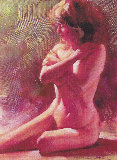-

-
Edward Willis Redfield
United StatesArt Brokerage: Edward Willis Redfield American Artist: b. 1869-1965. Edward Willis Redfield (December 18, 1869 – October 19, 1965) was an American Impressionist landscape painter and member of the art colony at New Hope, Pennsylvania. He is best known today for his impressionist scenes of the New Hope area, often depicting the snow-covered countryside. He also spent his summers on Booth Bay Harbor, Maine, where he interpreted the local coastline. He also frequently painted Maine's Monhegan Island. He showed artistic talent at an early age, and from 1887 to 1889 studied painting at the Pennsylvania Academy of the Fine Arts in Philadelphia. His teachers at the Academy included Thomas Anshutz, James Kelly and Thomas Hovenden. Anshutz really maintained the teaching methods of Thomas Eakins, which focused on an intense study of the nude as well as on human anatomy. While at the Academy, Redfield met Robert Henri, who was later to become an important American painter and teacher, and the two became lifelong friends. His other Academy friends included the sculptors Charles Grafly and Alexander Sterling Calder (the father of the noted modern sculptor of mobiles). Redfield with Robert Henri, later traveled to France and studied at the Académie Julian and the école des Beaux-Arts. At both French art academies, he studied with William Adolphe Bouguereau, one of the leading and best-known French academic painters. In Europe, Redfield admired the work of impressionist painters Claude Monet, Camille Pissarro, and Norwegian Fritz Thaulow. In France he met Elise Deligant, the daughter of an innkeeper, and the two married in 1893. Redfield and his wife returned to America and settled in Centre Bridge, Pennsylvania, near New Hope in 1898. He was one of the first painters to move to the area, and is sometimes considered a co-founder of the artist colony at New Hope along with William Langson Lathrop, who arrived in the same year. The impressionist landscapes of Edward Redfield are noted for their bold application of paint and vibrant color. Redfield painted en plein air, directly from nature rather than in a studio. He built a heavy impasto, "In one go" or in one session, usually outdoors, often under brutal winter weather conditions, roping the backs of his often huge canvases to trees, so that they would not blow away in the wind. Although during his lifetime, Redfield was acclaimed primarily for his winter landscapes, the spring scenes are among his most prized paintings today. Redfield died on October 19, 1965. Today his paintings are in many major museums, including the Metropolitan Museum of Art in New York City and the Smithsonian American Art Museum in Washington, DC. Redfield's catalogue raisonne is currently being compiled by art historian, Thomas Folk.
Read More + - Create Listing 0 Artworks for sale 4 Followers
-
We are actively seeking listings for Edward Willis Redfield.
Create a free listing or free wanted ad.
-
Art Wanted
We have interested buyers looking for these artworks by Edward Willis Redfield:
- CREATE AD
- Art Brokerage Requests (1)








